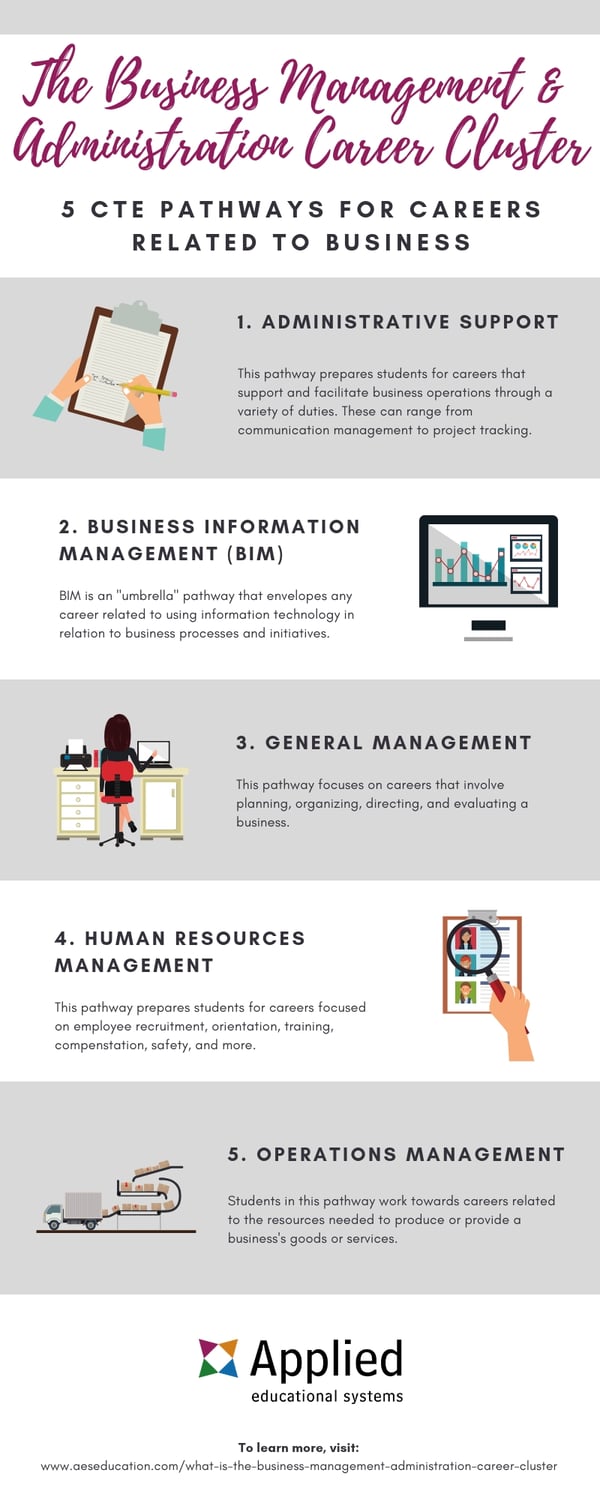Business Education | Career and Technical Education (CTE) | CTE Career Clusters
What Is the Business Management and Administration Career Cluster?
The Business Management and Administration career cluster is a national CTE track that helps students prepare for careers related to running an effective and productive business.
But what exactly does it mean for a student to be part of the Business Management and Administration career cluster?
On this page, we’ll discuss what career options are available in this cluster, what the cluster looks like in schools, and how you can help students succeed in your business classes and their careers.
But first, it’s crucial to know the career pathways within the Business Management and Administration cluster!
What Are the Business Management and Administration Career Pathways?

The business cluster is made of five specific career pathways for students interested in a business-related career.
The five national business career pathways are:
- Administrative Support
- Business Information Management
- General Management
- Human Resources Management
- Operations Management

Some states, like Georgia and Florida, have variations of these pathways that are more aligned with that state’s needs.
1. Administrative Support Pathway
The Administrative Support pathway prepares students for careers that support and facilitate business operations through a variety of duties. These duties can range from communication management to project tracking.
Overall, someone in this pathway must meet requirements related to:
- Communication skills
- Human resources management
- Information management
- Operations
2. Business Information Management Pathway
The Business Information Management (BIM) pathway is referred to as an “umbrella term,” meaning that it envelopes any career related to using information technology in relation to business processes and initiatives.
This pathway is especially important as businesses continue to collect more information on their customers. That information has to be secure and compliant with the laws that regulate it.
Students in the BIM pathway learn about five topics:
- Business law
- Financial analysis
- Information management
- Operations
- Strategic management
3. General Management Pathway
The General Management pathway focuses on careers that involve planning, organizing, directing, and evaluating a business.
Students in the General Management pathway are required to obtain knowledge and skills in seven areas:
- Business law
- Communication skills
- Economics
- Emotional intelligence
- Financial analysis
- Operations
- Strategic management
Overall, learning skills in these areas ensure that a student who enters a general management position will succeed in their career!
4. Human Resources Management Pathway
The Human Resources Management pathway prepares students for careers focused on employee recruitment, orientation, training, compensation, safety of employees, and more.
This pathway has the most diverse requirements for what students should know, with nine distinct topic areas:
- Business law
- Communication skills
- Emotional intelligence
- Financial analysis
- Human resources management
- Information management
- Marketing
- Operations
- Strategic management
5. Operations Management Pathway
The Operations Management pathway is focused on careers related to the resources needed to produce or provide a business’s goods or services.
Students in the Operations Management pathway must have knowledge and skills related to five areas:
- Business law
- Customer relations
- Financial analysis
- Information management
- Operations
Now that you’ve gotten a good grasp on the five career pathways, let’s move on to our next question -- what careers are available after completing these business pathways?
What Career Options Are Available in the Business Pathways?

In general, anyone would benefit from learning skills and concepts that fall under the business cluster, but there are some jobs that can’t be done without them!
Here’s a small sampling of the different careers available in each business pathway, along with data from the US Department of Labor’s Occupational Outlook Handbook:
Careers in Administrative Support
Someone working in administrative support will complete a variety of clerical and administrative duties.
In order to be successful in an administrative support career, someone will need to have excellent communications skills both with colleagues and clients.
In addition, someone in one of these careers should be very detail-oriented in order manage and track data.
Some common careers in this pathway include:
- Administrative assistant
- Paralegal
- Receptionist
Administrative assistants perform daily tasks such as organizing files, scheduling appointments, and preparing documents. In 2017, the median pay for administrative assistants was $37,870 per year.
Overall, while the outlook for administrative assistants is declining (-5%), as current employees move on, there will be a need for replacements.
Paralegals actively support lawyers by organizing files, drafting documents, and doing research. In 2017, the median annual wage for paralegals was $50,410 per year.
Overall, the job outlook for paralegals is up, with a 15% growth rate through 2026.
Receptionists perform a variety of administrative tasks including answering phones, greeting visitors, and providing general information about their company to others.
In 2017, the median pay for a receptionist was $28,390 per year. The job outlook for receptionists through 2026 is 9%.
Careers in Business Information Management
Business Information Management encapsulates a wide variety of careers related to the marrying of business and information technology.
However, everyone in this pathway needs to have a solid foundational knowledge of information management as it relates to using data to make decisions.
Some common careers in the Business Information Management pathway include:
- Accounting clerks
- Budget analyst
- Management analyst
Accounting clerks (sometimes called bookkeepers) are responsible for recording, maintaining, and auditing an organization’s financial records. In 2017, the median annual pay for an accounting clerk was $39,240. The job outlook for accounting clerks and bookkeepers through 2026 is essentially non-changing at -1%.
Budget analysts assist with preparing budget reports and spending for both public and private institutions. In 2017, the median annual wage for budget analysts was $75,240. With a 7% growth rate through 2026, this could be a great career option for someone in this pathway.
Management analysts (also referred to as management consultants) advice managers on how to improve efficiency in an organization by reducing costs and increasing revenue.
In 2017, the median pay for a management analyst was $82,450 per year. Overall, the job outlook for this type of career is looking good with a 14% growth rate through 2026!
Careers in General Management
Someone in the General Management pathway has a huge variety of potential careers. And while the types of careers are very different, anyone in this pathway must be well versed in strategic management and financial analysis.
Some career options in the General Management pathway are:
- Chief executive officer
- Compensation and benefits manager
- Entrepreneur
- Health services manager
Compensation and benefits managers oversee the programs that involve employee compensation. The median annual wage for this position was $119,120 per year in 2017.
Overall, the growth rate of compensation and benefits managers is relatively average at 5% through 2026.
Health services managers (also called healthcare executives) are responsible for planning, directing, and coordinating healthcare services. They could manage a hospital, clinic, or specific department. In 2017, the median pay for a medial services manager was $98,350 per year.
The job outlook for health services managers is much faster than average, with a 20% growth expectancy through 2026.
In addition to these more black-and-white careers, students in the General Management pathway often end up becoming entrepreneurs, business owners, or even chief executive officers!

Careers in Human Resources Management
The Human Resources Management pathway is one of the most specialized. While there are a number of skills that crossover from other pathways, someone interested in human resources will be extremely focused on communication amongst employees.
Some common careers in the Human Resources Management pathway include:
- Human resources manager
- Labor relations specialist
- Meeting, convention, and event planner
Human resources managers coordinate many administrative functions such as recruiting, interviewing, and hiring new staff. Very often they serve as the liaison between management and employees.
In 2017, human resources managers had a median annual pay of $110,120 per year. The outlook of this career is 9% growth through 2026.
Labor relations specialists interpret and administer labor contracts, specifically surrounding issues related to wages, healthcare, pensions, union practices, and more.
The median pay for labor relations specialists was $63,200 in 2017. While there are many positions available for this career, the job outlook is on a decline with -8% growth through 2026.
Meeting, convention, and event planners coordinate every aspect of events and professional meetings for their organization. As part of this they arrange locations, transportation, and more.
These types of planners had a median wage of $48,290 per year in 2017. Someone interested in this position has good opportunities ahead, since this career has a projected growth rate of 11% through 2026.
Careers in Operations Management
The Operations Management pathway requires an extreme attention to detail, especially when it comes to effectively providing goods or services to end customers.
Some common careers related to operations management include:
- Operations research analyst
- Sales manager
- Supply chain manager
Operations research analysts analyze information and data to identify and solve potential problems in order to help make better business decisions.
In 2017, the median annual wage for an operations research analyst was $81,390 per year. This career has the highest projected growth rate on any career we’ve listed – a whopping 27%!
Sales managers are responsible for directing a sales team by setting goals, analyzing data, and developing programs to train the team.
The median annual wage for sales managers was $121,060 in 2017. The growth rate of careers in sales management is projected at 7% through 2026.
Supply chain managers (sometimes called logisticians) analyze and coordinate the system and cycle that moves a product from the supplier to the consumer.
Supply chain managers had a median annual wage of $74,590 in 2019. The job outlook for this type of career is about average, with a growth rate of 7% expected through 2026.
For a full list of careers within the Business Management & Administration cluster, check out this Career Cluster Frame from Advance CTE.
So, you know the five business pathways and know what careers your students could enter into. But how is that translated into the classroom?
What Does the Business Management & Administration Cluster Look Like in Schools?

While most business education courses are found in the high school, the beginnings of the Business Management & Administration cluster can actually be found in middle school.
In some states, middle school students can take an introduction to business class. In other states, middle school business education topics are tied into career readiness or computer classes.
Overall, introducing concepts like professionalism, job-seeking skills, and customer service in earlier grades will set students up for success in more advanced business classes.
Once in high school, students interested in business have a wide variety of options across the country.
No matter which pathway a student plans on following, all high school business students typically take an introductory business course at some point.
Introduction to business courses vary from state to state, but there are some commonalities across nearly all of them.
In general, an introduction to business course is one semester long and includes concepts such as entrepreneurship, management, and marketing.
After completing the introductory course, students can take more focused, in-depth courses that directly align with their pathway and career goals.
These advanced courses can be year-long classes that involve both traditional classwork and a larger focus on project-based learning.
Some common courses at this level include:
- Accounting
- Business Law
- Entrepreneurship
- International Business
- Marketing
In addition to these classes, high school students in the business cluster can join FBLA.
FBLA, officially known as Future Business Leaders of America, is a career and technical student organization (CTSO) dedicated to preparing students for careers in business.
FBLA helps its members grow their leadership and business skills to shape them into “community-minded business leaders.”
Some FBLA events and activities take place in the classroom and others occur outside of school hours.
Many business education teachers are FBLA advisors or at least work with their local FBLA chapter to give their students the opportunities provided by the organization.
Overall, the Business Management & Administration cluster can be found in nearly every middle and high schools across the country.
But there’s still one big question remaining -- even with all of this knowledge about what the cluster entails, how do you prepare your students for success?
How to Prepare Students for Success in Business Courses and Their Careers
As a national CTE track, Business Management and Administration is full of opportunities for students in the successful operation of a business. Each pathway within the cluster offer students unique options to contribute to an organization.
However, learning about the Business Management and Administration cluster is only the first step to establishing a successful business education program.
To have a successful business education program, you'll need to overcome challenges many teachers face in their classrooms.
To learn how to manage everyday obstacles like satisfying course standards, balancing technology in the classroom, and meeting diverse student needs, download your free guide.
You'll learn how to overcome your biggest challenges as an educator and set your students up for success in business careers.

